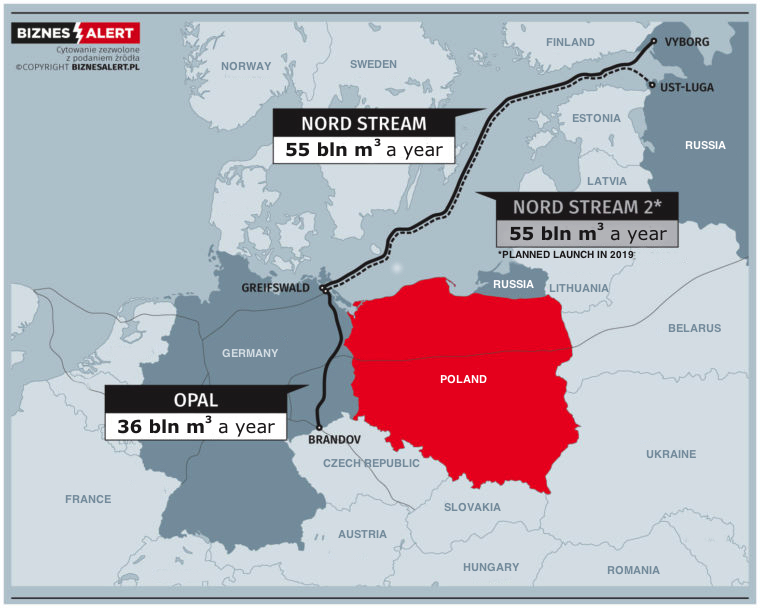The completion of Nord Stream 2 is becoming less likely. However, there is nothing to suggest that the project has lost Berlin’s support – Mariusz Marszałkowski, editor at BiznesAlert.pl, writes. These actions do not go with the declaration of solidarity and instead reveal the hypocrisy of Germany towards Central and Eastern Europe – the author believes.
Kremlin and the disastrous start of the year
All throughout 2020 Russia (as it is no longer just about Gazprom – the entire Russian state is involved) was taking considerable effort to finish the project as quickly as possible. A huge, considering Russia’s potential, fleet was put together, whose objective is to independently construct both lines of the gas pipeline in the Baltic Sea. A 'maskirovka’ was organized to protect the real owners of the ships against American sanctions and front companies were established. Crews were trained to conduct deep water works. Additionally, Russia spent millions of dollars to upgrade the Akademik Cherskiy.
One should not hope that after all that Russia has done in 2020 (just bringing 15 different vessels to the Baltic from every part of Russia was a huge challenge), it would give up on finishing the final 160 km of the pipe. Especially that the construction costs go up every day, both when it comes to the investment itself, as well as the lost profit that an operational pipeline would have generated by now. After all, at this point the pipe was supposed to have been working for at least six months. During that time over 60 bcm of gas would have been transported via the pipe and not via, e.g. Ukraine. This alone caused a USD 3 bn loss within one year.
Therefore, for the Kremlin this is no longer just a project that was supposed to have hooked the West on Russian gas, deprived Ukraine of transit profits or bolstered Gazprom’s monopolistic position in Central Europe. Now Nord Stream 2 has become a problem for Russia’s image and a big headache. New gas diversification projects are being put into operation, such as the FSRU unit in Croatia or the TAP gas pipeline from Azerbaijan to Italy. Other endeavors are being developed as well, including the Baltic Pipe between Poland and Norway. To make matters worse, gas prices, despite the recent rise, probably won’t go back to the level which had previously ensured unprecedented profits for Gazprom. That money was wasted on various political investments that even if economically dubious were deemed necessary.
The future of gas prices in Europe is also unclear. On the one hand, new projects are entering into service, which allow the buyer to negotiate the price (e.g. LNG from the USA, Norway, Qatar, Nigeria, or pipe gas from Algeria, Azerbaijan, or maybe in the future from Israel or Turkey). On the other hand, Europe is working towards climate neutrality, which in and of itself means in the long term that it will switch its economy to alternative fuels such as hydrogen, biogas or power generated from renewable energy sources (RES). Therefore, it remains questionable whether during its life span Nord Stream 2 (50 years, i.e. until 2070), would be able to achieve a return on the investment (especially considering the fact that the total investment cost includes the EUR 10 bn spent in the Baltic and the landfall investments in Russia and Germany).
January has been marked with U.S. sanctions…
The first jab that was taken at the project was the formal adoption of new U.S. sanctions as part of the Protecting Europe’s Energy Security Act 2021 (PEESA2021), which was included in the Pentagon spending bill formally titled the National Defence Authorization Act, which had been earlier vetoed by president Donald Trump, but whose objection was rejected by the House of Representatives controlled by the Democrats and the Republican-controlled Senate. It is worth mentioning that the determination in America will most likely remain strong with the arrival of the new administration headed by Joe Biden. Biden’s pick for the Secretary of State, Anthony Blinken said during his confirmation hearing that he was „determined to do whatever we can to prevent that completion…”. The new sanctions and their scope were summarized on BiznesAlert.pl.
Apart from adopting a new set of sanctions drafted specifically for the Nord Stream 2 project (and de facto the Turkish Stream as well), the United States has for the first time applied the Countering America’s Adversaries Through Sanctions Act (CAATSA), which was adopted in mid 2017. Until now such a move against Nord Stream 2 had been only on the wish list of the pipe’s opponents. However, on the 19th of January 2021 the Treasury Department announced it had imposed sanctions in accordance with section 232 of the CAATSA on the Russian barge Fortune and its owner KVT-RUS (which is actually a front created to shield the real owner of the vessel).
Americans apply these restrictions with pinpoint precision, which means they use the salami tactic in order to spread fear among European companies that are engaged in the Nord Stream 2 project. This should force those firms to withdraw from the investment on their own, which would allow Americans to avoid imposing sanctions on European entities. Taking aim at, e.g. German companies could flare up relations not only with the federal government, but with Germans as well, which means it is off the table.
Partners may retreat
It could be said that despite the tactic’s mediocre ability to attract big headlines, it is very effective. Since it has been exercised (i.e. the end of 2019) at least five large multinational companies have pulled out of the Nord Stream 2 project – a Dutch-Swiss maritime construction company Allseas, Denmark’s consulting and engineering firm Ramboll, Norway’s certification provider DNV-GL, the Zurich Insurance Group from Switzerland and Germany’s Bilfinger, a construction and engineering company. These firms are surely just the tip of the iceberg when it comes to the companies that decided to leave the project.
One could definitely add to the list companies that rent ships, which before the sanctions entered into force had actively participated in constructing the Nord Stream 2 by offering a wide array of vessels capable of laying pipes, supply ships, inspection ships or anchor handling tug vessels. Boskalis and Van Oord seem to have left the construction site as well. The companies provided rock placement services for the project, both under the pipe and in some sections on it. The work was performed by vessels called the Bravenes, Seahorse and Nordnes. Currently this is being done by the Murman, a Russian exploration ship that was adapted to do the job.
Apart from the companies that have left the constructions site fearing American sanctions, there are those which were strongly discouraging other companies from joining the project. In September the biggest association of maritime insurers – the P&I Club issued its warning and in October EF Marine did the same.
Little by little Gazprom started loosing its access to know-how from companies that were adept at implementing infrastructural projects at sea.
German hypocrisy
Another problem Gazprom had to face was the morally and legally doubtful decision made by Germany’s Federal Maritime and Hydrographic Agency https://biznesalert.pl/niemcy-nord-stream-2-gaz-energetyka-gazprom-bsh/(Bundesamt für Seeschifffahrt und Hydrographie – BSH) to change the construction permit. The original permit for the work in Germany’s construction zone (territorial waters and Exclusive Economic Zone) was issued by the Mining Office in Stralsund in March 2018. The document, apart from the technical aspects of the construction, included a few deadlines related to environmental issues.
Those included, among others, the cod fry and the sea birds breading season. According to the schedule, the builders could not perform any stationary work or build AWTI connections between sections between the 10th and 17th km (from the Danish-German EEZ border) between the 1st of November and 14th of May. The same limitation was imposed on the zone between the EEZ border up to the 17th km between the 1st of January and 14th of May. In July 2020 Nord Stream 2 AG submitted an application to the BSH to change the work windows in the permit. The company supported its request by claiming that „so far large numbers resting birds in the work area have not been recorded,” it also stated that anchored vessels did not cause noise as they „work at small speed” and lay pipes at 20 meters below the surface.
BSH agreed and allowed Gazprom to perform construction work during the previously banned period, which went against its decision from 2018 and the research on whose basis the permit was issued. BSH also explained that it was necessary to agree to the change as the project was delayed, which was not the investor’s fault (sic!), and added that the environmental limitations set out in the earlier permit could make the delay even worse.
Thanks to environmental organizations from Germany, which from the beginning have been fighting against Nord Stream 2 without much success, it was possible to temporarily suspend BSH’s decision. Both Naturschutzbund Deutschland (NABU) and Deutsche Umwelthilfe (DUH) contested BSH’s ruling, which automatically suspended the permit until the doubts are cleared. However, it is worth reminding that Germany’s federal institutions are very forgiving towards Nord Stream 2, and even try to support it. This is why the organizations’ objections will be most likely dismissed.
A very telling example of the tactics used by our western neighbors is the establishment of Stiftung Klima – und Umweltschutz MV (Foundation for the Protection of the Environment and Climate), whose main goal is to provide services to Nord Stream 2 by acting as an intermediary between companies able to deliver the necessary equipment for the project. The implicit assumption is that as a governmental institution (established by the Mecklenburg-Vorpommern state), the foundation would be „untouchable” from the point of view of American sanctions. By providing such a protective shield, the German state would see to it that Nord Stream 2 was completed. The Bild daily reported on the shocking details on how the foundation was established, including the fact that its statute was written by lawyers employed by the Nord Stream 2 AG consortium. Morover, the foundation’s initial budget is to be EUR 20.2, out of which Mecklenburg-Vorpommern would contribute EUR 200 thousand, whereas Nord Stream 2 AG EUR 20 m.
These actions go well with the declaration of solidarity and instead reveal the hypocrisy of Germany towards Central and Eastern Europe, he gauges.
Against all odds
Therefore, one could state that the completion of Nord Stream 2 is becoming less and less likely. Even Gazprom in its prospectus (necessary to take loans for billions of euros to, among others finish the Baltic project) has for the first time officially admitted that the risk of sanctions, and the changing political landscape across the world may result in halting, or even abandoning the project. This is surprising considering so far Gazprom has been arguing that the completion of the investment was inevitable regardless of the costs.
Russia will continue to push for finalizing the project as long as Germany does not withdraw its support. There is nothing to indicate that Nord Stream 2 has lost Berlin’s support. Germany’s political mainstream is hoping to overcome the problems thanks to the new administration in Washington. This is why German politicians, including the country’s foreign minister Heiko Mass, have revealed Berlin would immediately start consultations on the project with Joe Biden’s team. However, the new administration has already announced it would continue to support sanctions against the gas pipeline. Despite that, in 2021 Germany and Russia will use all of their behind-the-scenes political influence to get their way.









